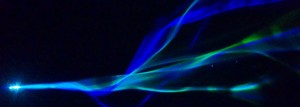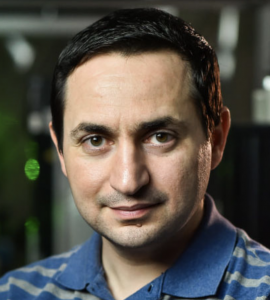A la Une de Nature : le Technion démontre le phénomène du flux de lumière ramifié

[:fr]
Un bel exemple de sérendipité. Alors qu’une équipe de chercheurs du Technion (Israel Institute of Technology) travaillait sur un autre sujet, elle a pu démontrer pour la première fois un flux de lumière ramifié. L‘équipe a combiné un faisceau laser à une membrane de savon et a découvert que lorsque la lumière se propage dans le film de savon, plutôt que d’être dispersée, la lumière forme des branches allongées, créant le phénomène de flux ramifié de lumière. Les résultats ont été présentés en Une de la prestigieuse revue Nature.
L’étude a été réalisée par le doctorant Anatoly (Tolik) Patsyk en collaboration avec Miguel A. Bandres, qui était boursier postdoc au Technion au début du projet et qui est à présent professeur adjoint au CREOL (College of Optics and Photonics, University of Central Florida). La recherche a été dirigée par le président du Technion, le professeur Uri Sivan et le professeur distingué Mordechai (Moti) Segev des facultés de physique et de génie électrique du Technion, du Solid State Institute et du Russell Berrie Nanotechnology Institute.

Lorsque les ondes rencontrent des obstacles, elles se dispersent naturellement, souvent dans toutes les directions. La diffusion de la lumière est un phénomène que l’on retrouve partout dans la nature. C’est la raison de la couleur bleue du ciel. « Lorsque la distance sur laquelle l’onde évolue est beaucoup plus grande que la longueur d’onde, l’onde se disperse de manière atypique : elle forme des canaux (branches) qui continuent de se diviser ou de se ramifier au fur et à mesure que l’onde se propage », explique Célia Kagan, étudiante ingénieur à l’ESME Sudria Paris. Ce phénomène est connu sous le nom d’écoulement ramifié. Il a été observé pour la première fois en 2001 dans des électrons et avait été suggéré comme omniprésent et se produisant également pour toutes les ondes dans la nature, par exemple les ondes sonores ou les vagues de l’océan. Les chercheurs du Technion apportent ce nouvel aspect du flux ramifié au domaine de la lumière : ils ont observé expérimentalement le flux ramifié de la lumière.

«Nous voulions découvrir quelque chose de nouveau. Ce n’était pas ce que nous cherchions mais nous avons trouvé bien mieux», explique avec enthousiasme le Pr assistant Miguel Bandres. «Nous savons comment les ondes se propagent dans un milieu homogène. Mais ailleurs, elles peuvent se comporter de manière très différente. Dans un paysage de montagnes et de vallées, les ondes se propagent d’une manière particulière. Elles forment des canaux qui continueront de se diviser à mesure que l’onde se propage, formant un beau motif ressemblant aux branches d’un arbre. »
«En optique, nous travaillons dur pour que la lumière reste focalisée et se propage comme un faisceau collimaté (lumière dont les rayonnements sont quasiment parallèles et se déploient lentement quand ils se propagent), mais ici la surprise est que malgré la structure aléatoire du film de savon la lumière est restée focalisée », explique Tolik Patsyk.
Pouvoir créer un écoulement ramifié dans le domaine de l’optique offre de nouvelles opportunités passionnantes pour étudier et comprendre ce phénomène universel.

«C’est la première démonstration de ce phénomène. Cela montre que des phénomènes étranges peuvent être observés dans des systèmes simples et qu’il suffit d’être perspicace. Assembler et combiner les points de vue de chercheurs pluridisciplinaires a conduit à des perspectives vraiment intéressantes. Pouvoir observer avec des ondes lumineuses ouvre de nouvelles possibilités de recherche remarquables : nous pourrions caractériser le milieu dans lequel la lumière se propage avec une très grande précision, suivre ces branches et étudier leurs propriétés », explique le Pr Uri Sivan, président du Technion.
Le Prof. Moti Segev décrit : «J’enseigne toujours à mon équipe à penser au-delà de l’horizon et en même temps à regarder les faits expérimentaux tels qu’ils sont, plutôt que d’essayer d’adapter les expériences pour répondre à certains comportements attendus. Tolik essayait de mesurer quelque chose de complètement différent et a été surpris de voir ces branches fluides qu’il ne pouvait pas expliquer initialement. Avec Miguel, ils ont considérablement amélioré les expériences. Alors nous avons commencé à comprendre ce que nous observions. Il nous a fallu plus d’un an pour comprendre l’étrange phénomène de «flux ramifié», qui à l’époque n’était jamais envisagé dans le contexte des ondes lumineuses. Maintenant, avec cette découverte nous pouvons penser à une pléthore de nouvelles idées». Moti Segev pense que cette découverte pourrait s’appliquer au domaine médical en permettant un examen plus précis des vaisseaux sanguins et des veines et résoudre certains problèmes de santé.
Le projet se poursuit désormais dans les laboratoires des Profs. Segev et Sivan au Technion et en parallèle dans le tout nouveau laboratoire du Pr Miguel Bandres à l’UCF (University of central Florida).
[:en]
A team of researchers from Technion – Israel Institute of Technology has observed branched flow of light for the very first time. The findings are published in the prestigious scientific journal Nature and are presented on the cover of the July 2, 2020 issue.
The study was carried out by Ph.D. student Anatoly (Tolik) Patsyk in collaboration with Miguel A. Bandres, who was a postdoctoral fellow at Technion when the project started and is now Assistant Professor at CREOL, College of Optics and Photonics, University of Central Florida. The research was led by Technion President Prof. Uri Sivan and Distinguished Prof. Mordechai (Moti) Segev of Technion’s Physics and Electrical Engineering Faculties, the Solid State Institute, and the Russell Berrie Nanotechnology Institute.
When waves travel through landscapes that contain disturbances, they naturally scatter, often in all directions. Scattering of light is a natural phenomenon, found in many places in nature. For example, the scattering of light is the reason for the blue color of the sky. As it turns out, when the length over which disturbances vary is much larger than the wavelength, the wave scatters in an unusual fashion: it forms channels (branches) of enhanced intensity that continue to divide or branch out, as the wave propagates. This phenomenon is known as branched flow. It was first observed in 2001 in electrons and had been suggested to be ubiquitous and occur also for all waves in nature, for example – sound waves and even ocean waves. Now, Technion researchers are bringing branched flow to the domain of light: they have made an experimental observation of the branched flow of light.

“We always had the intention of finding something new, and we were eager to find it. It was not what we started looking for, but we kept looking and we found something far better,” says Asst. Prof. Miguel Bandres. “We are familiar with the fact that waves spread when they propagate in a homogeneous medium. But for other kinds of mediums, waves can behave in very different ways. When we have a disordered medium where the variations are not random but smooth, like a landscape of mountains and valleys, the waves will propagate in a peculiar way. They will form channels that keep dividing as the wave propagates, forming a beautiful pattern resembling the branches of a tree.”
In their research, the team coupled a laser beam to a soap membrane, which contains random variations in membrane thickness. They discovered that when light propagates within the soap film, rather than being scattered, the light forms elongated branches, creating the branched flow phenomenon for light.
“In optics we usually work hard to make light stay focused and propagate as a collimated beam, but here the surprise is that the random structure of the soap film naturally caused the light to stay focused. It is another one of nature’s surprises,” says Tolik Patsyk.
The ability to create branched flow in the field of optics offers new and exciting opportunities for investigating and understanding this universal wave phenomenon.

“There is nothing more exciting than discovering something new and this is the first demonstration of this phenomenon with light waves,” says Technion President Prof. Uri Sivan. “This goes to show that intriguing phenomena can also be observed in simple systems and one just has to be perceptive enough to uncover them. As such, bringing together and combining the views of researchers from different backgrounds and disciplines has led to some truly interesting insights.” “The fact that we observe it with light waves opens remarkable new possibilities for research, starting with the fact that we can characterize the medium in which light propagates to very high precision and the fact that we can also follow those branches accurately and study their properties,” he adds.
Distinguished Prof. Moti Segev looks to the future. “I always educate my team to think beyond the horizon,” he says, “to think about something new, and at the same time – look at the experimental facts as they are, rather than try to adapt the experiments to meet some expected behavior. Here, Tolik was trying to measure something completely different and was surprised to see these light branches which he could not initially explain. He asked Miguel to join in the experiments, and together they upgraded the experiments considerably – to the level they could isolate the physics involved. That is when we started to understand what we see. It took more than a year until we understood that what we have is the strange phenomenon of “branched flow”, which at the time was never considered in the context of light waves. Now, with this observation – we can think of a plethora of new ideas. For example, using these light branches to control the fluidic flow in liquid, or to combine the soap with fluorescent material and cause the branches to become little lasers. Or to use the soap membranes as a platform for exploring fundamentals of waves, such as the transitions from ordinary scattering which is always diffusive, to branched flow, and subsequently to Anderson localization. There are many ways to continue this pioneering study. As we did many times in the past, we would like to boldly go where no one has gone before.”
The project is now continuing in the laboratories of Profs. Segev and Sivan at Technion, and in parallel in the newly established lab of Prof. Miguel Bandres at UCF.
Publication in Nature July 2nd 2020
[:]







